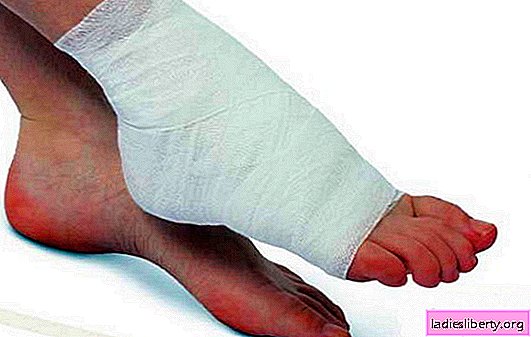
The ankle joint consists of three bones: tibial, fibular and talus.
All these bone tissues are connected by a dense tendon and muscles, due to which the joint is active.
Let us consider in more detail the main reasons why the ankle joint swells and the methods of treating this disorder in the musculoskeletal system.
Why the ankle joint swells: reasons
Most often, edema occurs in this joint for the following reasons:
1. Damage to the foot. The following types of injuries fall into this category:
• sprain. It is accompanied by swelling of the limb due to internal hemorrhage and acute pain. Often a person after such an injury cannot fully step on his leg;
• an ankle fracture is accompanied by severe pain during palpation, bone crunch, as well as rapid swelling of the limb;
• bruised ankle joint may be accompanied by pain and the appearance of bluishness on the skin due to subcutaneous hemorrhage;
• dislocation of the joint. It usually occurs when wearing shoes with too high heels. Also, this can happen with fat people who have a weakened ligamentous apparatus. As a rule, this injury is accompanied by swelling of the joint, however, it itself passes through two to three weeks with gentle treatment.
2. Deforming arthrosis - This is a disease that leads to a decrease in the functionality of the ankle joint. With untimely treatment, it can provoke serious consequences and disability.
Most often, deforming arthrosis develops after a limb injury, in which one of the three bones of the joint was damaged. Because of this, the surface of the broken bone becomes uneven and rough, which leads to a deterioration in the process of sliding and trauma during the active work of the joint itself.
Symptoms of this disease are quite different. A person can suffer from impaired gait, pain when moving for long distances, frequent swelling of the joint and swelling of the limb. In more advanced cases, severe inflammation can develop in the body, which will lead to high temperature.
It is important to know that this form of arthrosis is very dangerous, since it damages the human musculoskeletal system. As a result, with the first suspicions of its development, you need to see a doctor and conduct a thorough diagnosis.
3. Tendonitis - This is a disease in which the tendon of the ankle joint is very inflamed (it connects the calcaneus to the muscles of the lower leg).
The cause of tendonitis may be a previously suffered tendon rupture, injury or infection.
Most affected by this disease are professional athletes (runners, soccer players, basketball players, etc.) who put a lot of stress on their legs and suffer frequent injuries.
Symptoms of tendonitis are aching pain in the joint, its edema, which increases most in the evening and fever.
4. Gout. It is inherent in older people who suffered injuries of the ankle joint at a young age. Gout is characterized by chronic aching pains, which most often occur at night, preventing a person from falling asleep.
It is important to know that gout can also develop as a result of untreated arthritis and other diseases that cause inflammation in the joint. In addition, overweight and a sedentary lifestyle are also considered a prerequisite for its appearance.
5. Circulatory disturbance in the extremities can also cause joint swelling and pain. This problem is usually observed in both legs simultaneously, respectively, causing swelling of both ankle joints.
In this state, it is very difficult for a person to walk even at short distances, climb stairs and perform other physical activities.
Also, these edema is called peripheral. They can occur with blockage of blood vessels, their aging or varicose veins.
6. Pregnancy It can also affect the swelling of the ankles, especially in the third trimester of course, when a woman's body is subjected to heavy stress.
7. Overweight.
8. Kidney Disease, because of which these organs are not able to timely remove fluid from the body, which leads to swelling of the face and limbs.
9. Vascular obstruction. Usually, this disease occurs when they become clogged with a blood clot, which caused thrombosis and swelling of the leg. If this problem is not resolved in time, then edema may occur throughout the limb.
10. The presence of infection in the soft tissues of the ankle can provoke a throbbing pain and swelling of the ankle joint. At the same time, the person will also suffer from fever (the body thus reacts to foreign bacteria and inflammation). It is best to treat infections with medications, since viruses must be suppressed, otherwise they will multiply all the time and further aggravate the human condition.
Additional causes of swelling and pain in the ankle joint are:
• cirrhosis of the liver;
• following an unbalanced diet;
• an insect bite that caused allergies and swelling;
• chronic liver disease;
• acute heart failure;
• poor nutrition;
• the period of menstruation in women.
Ankle pain: how to treat
If you experience pain in the ankle joint, you need to contact a traumatologist as soon as possible. After the examination, the doctor will prescribe such mandatory diagnostic procedures (they will help to more accurately identify the disease):
• ultrasound of the joint;
• general blood analysis;
• general urine analysis;
• MRI of the joint;
• CT;
• radiography.
Pain in the ankle joint is treated comprehensively, depending on the diagnosed disease, the patient's symptoms and his general condition.
Drug therapy provides for the appointment of such groups of drugs:
1. Anti-inflammatory drugs (Movalis, Diclofenac, Vltaren, etc.).
2. Anesthetics (Fastum-gel, Diclac-gel).
3. Medicines that improve blood circulation in the body.
4. With a rapid deterioration of the patient's condition, he may be prescribed injections with corticosteroids, which will be administered intraarticularly. Usually this treatment takes 8-10 procedures.
5. Taking non-steroidal anti-inflammatory drugs (Nmesulide, Celecoxib).
With the ineffectiveness of drug therapy while maintaining pain and inflammation in the patient, surgical treatment may be prescribed. The most effective today is the replacement of the joint with an artificial endo prosthesis.
How to treat an ankle joint if it hurts: physiotherapy
Physiotherapeutic treatment involves the following procedures:
1. Massage.
2. Phonophoresis.
3. Magnetotherapy.
4. Laser treatment.
5. UHF therapy.
These procedures are effective to quickly relieve inflammation and pain. They can be prescribed only after drug therapy and pain relief in the patient.
Also, for pain in the ankle joint, it is recommended to adhere to such treatment rules:
1. Rewind the affected joint with an elastic bandage so that it helps restore impaired circulation.
2. Lay a sore foot on a high pillow. This will also help reduce edema and improve blood circulation.
3. When diagnosing arthrosis, tendonitis, arthritis, or other joint diseases, the load on the sore leg should be completely eliminated. To do this, it is recommended to use a cane or crutch.
4. In case of injury, immediately apply cold to the leg to prevent the development of severe edema and hematoma, otherwise, otherwise, it will have to be removed surgically.
5. If you suspect an ankle fracture, it is very important not to try to straighten your leg yourself. It can only do harm. You should wait for the arrival of doctors and take an x-ray. After that, the doctor will determine the degree of injury and take the right action.
Ankle pain: how to treat it and prevent the occurrence of the disease
In order to prevent the development of pain in the ankle joint, one should adhere to such prevention recommendations:
1. Wear flat shoes.
2. Avoid excessive physical exertion on the legs.
3. Enrich your diet with foods containing calcium and magnesium.
4. In time to treat even minor bruises and injuries of the ankle joint.
5. Go in for sports - be active.
6. Treat diseases of the internal organs that can cause pain in this joint.











